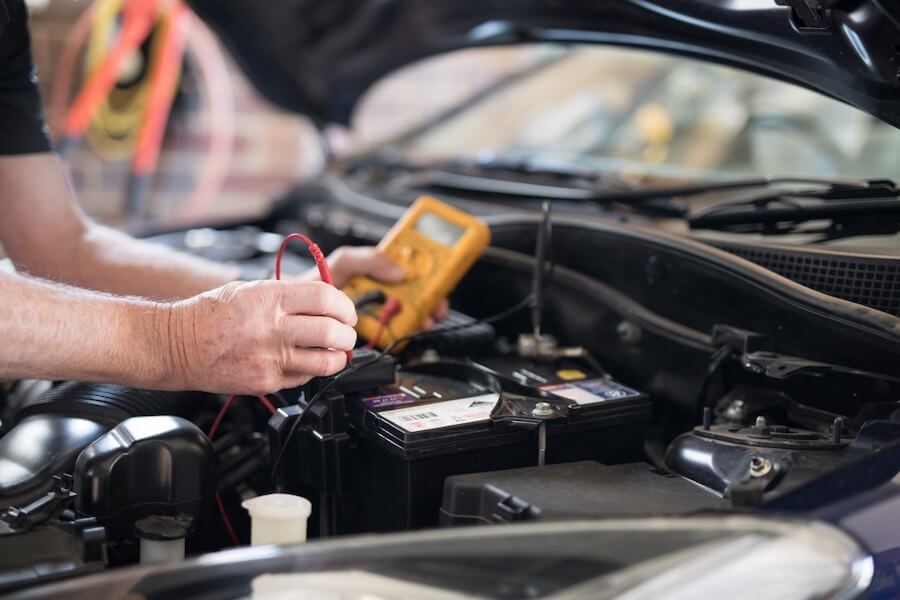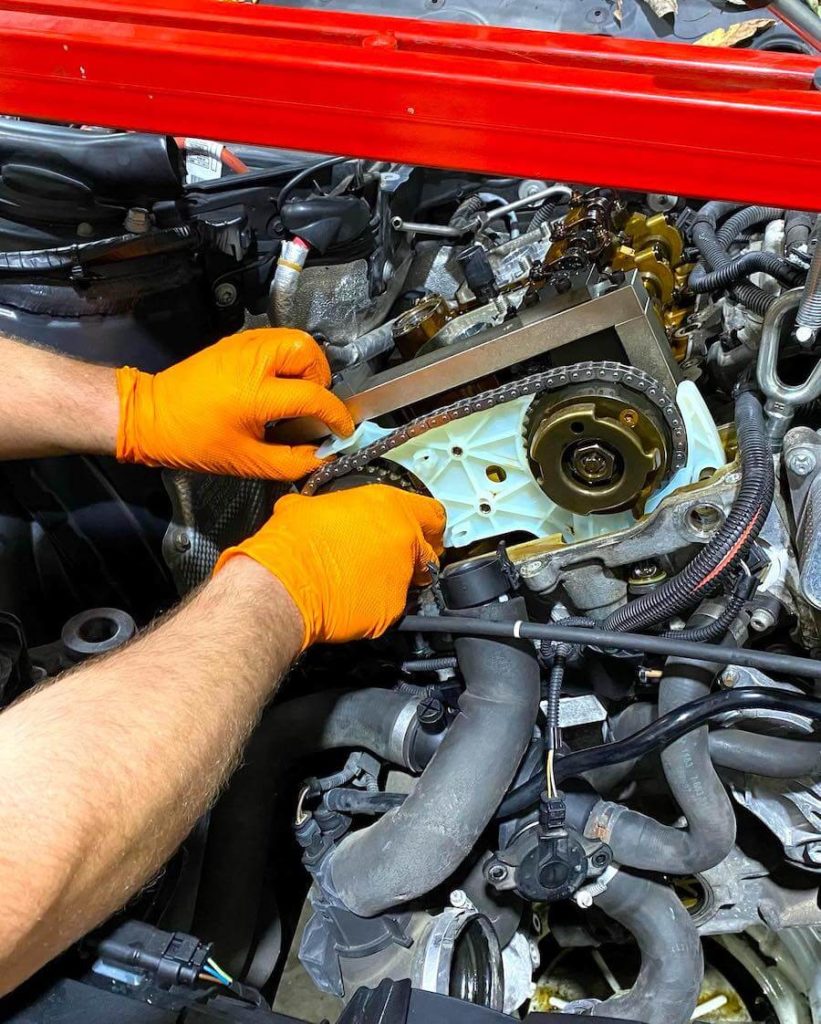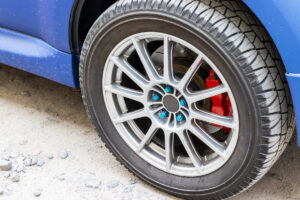The check engine light is a warning light that comes up on the dashboard of your car. It’s usually yellow or orange and has an image of a car running. If you see this, it means something with one of your car’s systems isn’t working properly and needs to be looked at as soon as possible.
The check engine light usually turns on due to causes related to emissions or fuel efficiency, damaged or worn spark plugs, catalytic converter problems, engine coolant problems, or sensor malfunction. If the light is blinking, it’s best to call a professional mechanic to troubleshoot the problem.
Read on for more details about the check engine light, what you can do about it, and why you should call an expert to help solve the problem.

Why Your Car’s Check Engine Light Is On
As I mentioned, a car’s check engine light will come on due to several reasons. However, without insights into the potential causes, you may end up spending a lot of time and money looking for the problem.
Here’s a rundown of some of the common reasons your BMW or Subaru’s check engine light will turn on:
The Gas Cap Is Not Tightened Enough
When your car’s gas cap is loose or missing, it can cause the check engine light to come on.
A loose or missing cap means that fuel will evaporate instead of being stored in the tank, which means you’re not getting proper mileage.
Fortunately, this is an easy problem to fix — make sure your gas cap is tightened all the way.
Note: A faulty gas cap can cause other problems with your car’s emissions system, so it’s best to replace your old one if it gets damaged or lost.
Spark Plugs Misfiring
If your engine has many miles on it, the spark plugs may become misfiring or dirty.
This can prevent certain cylinders from firing and lead to problems like low fuel efficiency and power loss. This, in turn, can cause your check engine light to come on.
In this case, you should consider replacing the spark plugs. You can ask your mechanic to perform a tune-up, which will help take care of dirty or misfiring plugs simultaneously.
Engine Coolant Temperature Sensor Malfunction
Another common sensor affecting your car’s fuel efficiency and emissions system is the engine coolant temperature sensor (ECT).
This little guy sends information about how hot your BMW or Subaru’s engine is to the computer so knows what type of operation to perform.
A faulty ECT can cause the check engine light due to excessive emissions or poor fuel mileage.
Catalytic Converter Problems
The catalytic converter is a big, clunky part that can be found underneath your car. It has the job of eliminating harmful gases from engine exhaust.
When it doesn’t work properly, your check engine light will turn on, and you’ll get poor fuel mileage.
In this case, you should get the catalytic converter looked at by a mechanic as soon as possible to prevent further damage to your vehicle.
Oxygen Sensor Problems
The oxygen sensor (O2 sensors) are used to monitor the amount of oxygen in your exhaust. The computer needs this information to get accurate fuel efficiency and emissions data.
If this sensor isn’t working properly, it can lead to trouble with engine performance, bad fuel mileage, and eventually even emitting too many pollutants — which will cause your check engine light to come on.
Here’s a 7-minute video that describes the common causes of the check engine light:
What To Do When You Get a Check Engine Light
If your check engine light comes on, you should get it checked out by a mechanic right away.
It’s important to have the underlying problem correctly diagnosed so that you can prevent any permanent damage.
In this case, I recommend using this LAUNCH OBD2 Scanner from Amazon.com to diagnose the problem. It’s versatile and works on all car models.
The following checklist will help you figure out what might be wrong with your car when the check engine light pops up:
- Write down when you first noticed the check engine light turning on.
- Check the car’s gas cap to see if it’s loose or missing.
- Take out your car’s manual to determine what code(s) lights up when the check engine light is on.
- Consider any recent changes you’ve made to your vehicle, including a tune-up, new oil, or gas cap replacement.
- Look up the codes generated by your car’s computer system to see any common causes of recent problems.
- Check for any error messages that may have popped up on a different display in your vehicle. This can help identify possible errors with specific components or systems of your car.
- Make a note of anything abnormal about your car’s performance. This can help you pinpoint what exactly is causing the engine light to come on.
Caution: Be sure to check whether the light is blinking or solid. If it’s blinking, pull over and call a tow truck immediately. A blinking sign means the problem is severe and needs immediate attention.
How To Fix A Check Engine Light
If you check the manual and find the code(s) that show up when your car’s check engine light is on, there are typically some steps to resolve the problem.
You’ll need to figure out which step resolves your issue (and does not damage your vehicle). After each step, you should re-check your car’s engine light to see if it has turned off.
If the check engine light is still on after several steps, then there may be a more serious problem with your car, and you should have it looked at by a mechanic.
There are some common repairs that you can perform to resolve the issues with your BMW or Subaru’s check engine light:
- Gas cap replacement: If your check engine light comes on because the gas cap is loose or missing, then replacing it can resolve that issue.
- Tune-up: Having a tune-up will help correct errors with fuel mileage and emissions system performance. If you recently had a tune-up but still have problems, then the chances are that the tune-up did not fix the problem, and you will need diagnostics run to identify the issue.
- Oil change: If your car doesn’t perform well with regular oil, changing it out for synthetic may resolve this issue.
- Filter replacement: Check to see what filters need to be replaced (i.e., cabin air or fuel filter) and replace them to see if that’s the problem.
- Idle control valve replacement: This is common for getting rid of bucking problems when starting up your engine after it has been turned off.
- O2 sensor replacement: If only one O2 sensor is giving you trouble, then replacing just that one can resolve your issue without replacing all the sensors.

When To Call Your Mechanic To Look At The Problem
If the check engine light isn’t solid but keeps blinking, don’t attempt any repairs yourself. Instead, call a professional mechanic to troubleshoot the problem.
Even if you think you know what the problem is, fixing it yourself can cause permanent or costly damage to your BMW or Subaru.
It’s always best to have an experienced mechanic look at your engine light code(s) to see the underlying issue and how to fix it, as there could be other problems with your car that a less-experienced person might not catch.
Be sure to be as descriptive as possible when explaining the problem you’re having and what you’ve done so far to fix it. This will help your mechanic find the problem and resolve it more quickly.
Preventative Maintenance Tips for Your Car
Now that you know about the engine light, what it means when it comes on, and how to fix some common problems you might have with your vehicle, there are some things that you can do to maintain your car and avoid some of the problems that cause the check engine light to come on.
Here are some tips to keep in mind for maintaining your car:
Keep Your Car’s Records Updated
Keep any records for your vehicle up to date in case you need to show it to a mechanic.
This will help the mechanic understand what’s wrong with your car and give them an idea of what types of problems they should expect when looking at your car’s computer system.
It’ll also allow them to find problems that may not have shown up before but are now showing because of other repairs you’ve recently made.
Know the Warning Signs of Your Vehicle
When you get regular tune-ups, check to see what types of problems your car’s “check engine light” is warning you about.
Knowing these warning signs and checking them yourself will help save time when dealing with the issue that causes your car’s engine light to come on.
If you aren’t sure where to look, bring your car in for a tune-up or oil change and ask them to look up what the warning lights mean to figure out what’s going on.
Perform Regular Maintenance
Regular maintenance is a good way to prevent problems that cause your engine light to come on.
It’s good for the health of your car and puts you back in control of what happens with your car, which can help prevent some costly repairs from happening.
Keep these things in mind if you want to maintain your car and avoid dealing with engine trouble:
Fix Any Leaks Promptly
Your fluids (oil, coolant, transmission fluid, etc.) should be checked and replaced regularly.
If your car leaks any of these fluids, then you should bring your car in right away.
The sooner the problem is fixed, the better — don’t wait until it’s too late since that’ll only make the problem more severe and increase repair costs!
Don’t Ignore Rattling Sounds
If your car makes any weird noises, no matter how small you think they are, then get them checked out ASAP.
It might be something completely minor and easy to fix, or it could be a sign of a major problem that’ll cost a lot more to fix later on down the road.
Final Thoughts
The check engine light is your car’s way of telling you that something is wrong. You can resolve some issues without too much trouble, but it’s always best to get a professional mechanic to diagnose the problem and fix it for you.
If the light comes on, you might want to consider bringing in your car for regular maintenance or having it looked at by SL Autoworks’ experienced mechanics who can help you figure out what’s behind the warning light and how to resolve the underlying problem(s).



